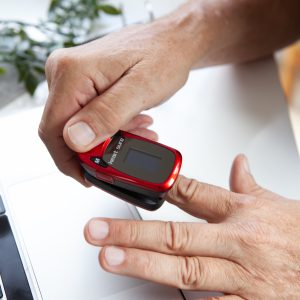FREE SHIPPING OVER $99
- Home
- Blog
- Health Devices
- What do pulse oximeters do?

What do pulse oximeters do?
A pulse oximeter measures the level of oxygen in your blood. Strictly speaking, it measures oxygen saturation, and the reading is abbreviated to ‘Sp02’, where ‘S’ indicates saturation; P indicates pulse, also SP can stand for serum pressure and 02 is oxygen. It calculates how much oxygen your blood is carrying compared to the maximum it is capable of.1 Under normal circumstances, it should be over 95%.2
Best of all, the measuring process is easy and painless, but it helps healthcare professionals determine how well oxygen is being delivered to the parts of your body furthest from your heart, such as the arms and legs.3
A pulse oximeter is a small device that usually clips onto your finger. If you’ve ever been in hospital or visited a patient, there’s a good chance you will have seen one. In fact, pulse oximetry is so widely used in medical care that it is often regarded as a fifth vital sign.4
Vital signs are “critical indicators of a person’s health and current medical status”.5
Traditionally, clinicians were interested in four vital signs:
- Body temperature
- Pulse (heart rate)
- Respiratory rate (rate of breathing)
- Blood pressure
So, clearly, oxygen saturation/levels are very important.
How does it work?
When the pulse oximeter is attached, it passes light through one side of your finger onto a light detector on the other side. As it passes through your finger, the light hits your blood cells and reacts differently to the cells carrying oxygen, compared to the cells not carrying oxygen. Basically, it measures the colour of blood, which is brighter red when there is more oxygen in it.6
Sophisticated technology inside the pulse oximeter then calculates and displays the SpO2 or oxygen level.
Why is it useful?
A pulse oximeter is useful because it can show whether your heart and lungs are supplying enough oxygen to vital organs – including your brain.7
Under certain conditions, oxygen levels can fall, and that can cause serious problems. For example, if you suffer from a condition or disease that affects your lung function, or you have heart disease, that can impact the capacity of your red blood cells to carry enough oxygen.7
Exercise can also affect blood oxygen levels because oxygen is needed to turn food into fuel to keep you going. The harder you exercise, the more oxygen your body needs. That’s why you breathe harder when you exert yourself.8
So, whether you’re looking to monitor your health or your fitness, you might find a pulse oximeter a useful addition to your home. It can be used pre/post exercise or pre/post operative conditions. The good news is that they’re simple to use and not very expensive. You can check out the #1 Pulse Oximeter Brand in Australian Pharmacy* Heart Sure Pulse Oximeter here.
Always read the label and follow the directions for use. Consult your health professional to evaluate the readings.
*IQVIA™, RMS/Sell Out Service, IQVIA defined Oximeter category market, Total value Sales, 52 weeks to 15th Jan 2022.
Sources:
- https://www.thoracic.org/patients/patient-resources/resources/pulse-oximetry.pdf
- https://www.medicinenet.com/what_are_blood_oxygen_levels/article.htm
- https://www.hopkinsmedicine.org/health/treatment-tests-and-therapies/pulse-oximetry
- https://www.sciencedirect.com/science/article/pii/S095461111300053X
- https://www.sciencedirect.com/sdfe/pdf/download/eid/3-s2.0-B9780721603612500259/first-page-pdf
- https://www.theguardian.com/australia-news/2022/jan/20/what-is-a-pulse-oximeter-and-can-i-still-buy-one-in-australia-demand-for-devices-climbs-as-more-people-manage-covid-at-home
- https://www.webmd.com/lung/pulse-oximetry-test
- https://www.blf.org.uk/support-for-you/how-your-lungs-work/why-do-we-breathe
Tags
Leave a Comment Cancel reply
SUBSCRIBE
Subscribe to our mailing list so that you can be the first to know about new products and promotions.
© 2024. All Rights Reserved.





